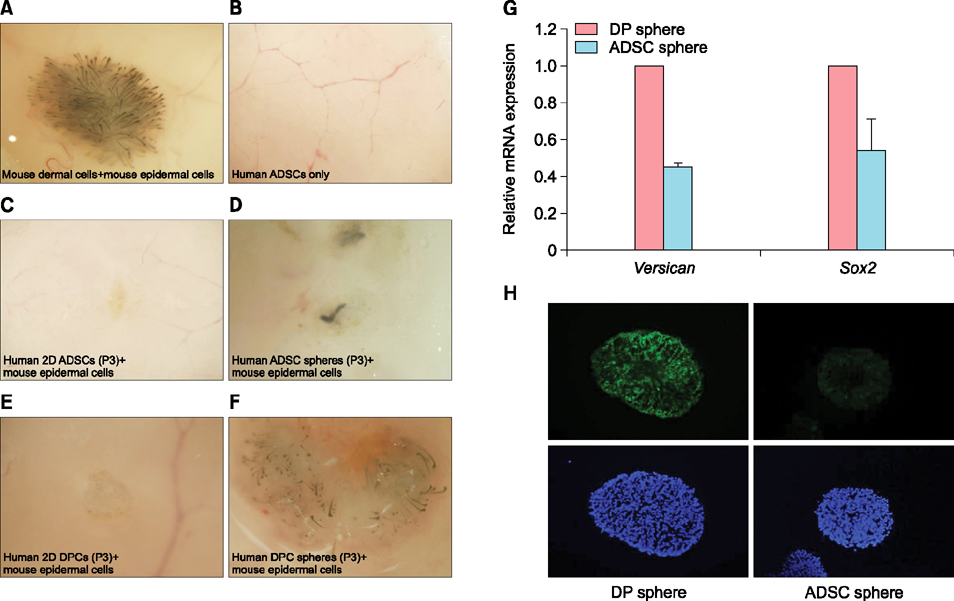Ann Dermatol.
2016 Oct;28(5):662-665. 10.5021/ad.2016.28.5.662.
Poor Capability of 3D-Cultured Adipose-Derived Stem Cells to Induce Hair Follicles in Contrast to 3D-Cultured Dermal Papilla Cells
- Affiliations
-
- 1Department of Immunology, Kyungpook National University School of Medicine, Daegu, Korea. ysung@knu.ac.kr
- 2Department of Biomedical Science, CHA University, Seongnam, Korea.
- 3Hair Transplantation Center, Kyungpook National University Hospital, Daegu, Korea.
- KMID: 2382902
- DOI: http://doi.org/10.5021/ad.2016.28.5.662
Abstract
- No abstract available.
MeSH Terms
Figure
Cited by 1 articles
-
Impairment of Hair-Inducing Capacity of Three-Dimensionally Cultured Human Dermal Papilla Cells by the Ablation of STAT5
Chang Hoon Seo, Mi Hee Kwack, Moon Kyu Kim, Jung Chul Kim, Young Kwan Sung
Ann Dermatol. 2019;31(2):228-231. doi: 10.5021/ad.2019.31.2.228.
Reference
-
1. Driskell RR, Clavel C, Rendl M, Watt FM. Hair follicle dermal papilla cells at a glance. J Cell Sci. 2011; 124:1179–1182.
Article2. Ohyama M, Zheng Y, Paus R, Stenn KS. The mesenchymal component of hair follicle neogenesis: background, methods and molecular characterization. Exp Dermatol. 2010; 19:89–99.
Article3. Ohyama M, Veraitch O. Strategies to enhance epithelialmesenchymal interactions for human hair follicle bioengineering. J Dermatol Sci. 2013; 70:78–87.
Article4. Kang BM, Kwack MH, Kim MK, Kim JC, Sung YK. Sphere formation increases the ability of cultured human dermal papilla cells to induce hair follicles from mouse epidermal cells in a reconstitution assay. J Invest Dermatol. 2012; 132:237–239.
Article5. Strem BM, Hicok KC, Zhu M, Wulur I, Alfonso Z, Schreiber RE, et al. Multipotential differentiation of adipose tissuederived stem cells. Keio J Med. 2005; 54:132–141.6. Driskell RR, Jahoda CA, Chuong CM, Watt FM, Horsley V. Defining dermal adipose tissue. Exp Dermatol. 2014; 23:629–631.
Article7. Driskell RR, Lichtenberger BM, Hoste E, Kretzschmar K, Simons BD, Charalambous M, et al. Distinct fibroblast lineages determine dermal architecture in skin development and repair. Nature. 2013; 504:277–281.
Article8. Kwack MH, Sung YK, Chung EJ, Im SU, Ahn JS, Kim MK, et al. Dihydrotestosterone-inducible dickkopf 1 from balding dermal papilla cells causes apoptosis in follicular keratinocytes. J Invest Dermatol. 2008; 128:262–269.
Article9. Zuk PA, Zhu M, Ashjian P, De Ugarte DA, Huang JI, Mizuno H, et al. Human adipose tissue is a source of multipotent stem cells. Mol Biol Cell. 2002; 13:4279–4295.
Article10. Park KC, Choi HR, Na JI, Cho HJ, Nam KM, Choi JW, et al. Effects of murine dermal cells on the regulation of hair growth is dependent on the cell number and post-natal age of newborn mice. Ann Dermatol. 2012; 24:94–98.
Article
- Full Text Links
- Actions
-
Cited
- CITED
-
- Close
- Share
- Similar articles
-
- Effects of Alopecia Areata Serum on Proliferation of Cultured Dermal Papilla Cells
- The Effect of Medications Used in Mesotherapy on Hair Organ Culture and Culture of Dermal Papilla Cells
- Effects of Vaseular Endothelial Growth Factors on Hair Growth in Vitro
- Effects of Substance P on the Expression of Various Factors to control Hair Growth in Human Hair Follicle Culture
- Effects of Calcitonin Gene-Related Peptide on the Hair Growth in Human Hair Follicle Organ Culture


